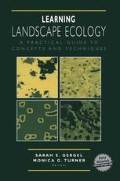Access this chapter
Tax calculation will be finalised at checkout
Purchases are for personal use only
Preview
Unable to display preview. Download preview PDF.
Bibliography
Gardner, R. H. 1999. RULE: A program for the generation of random maps and the analysis of spatial patterns. In J. M. Klopatek and R. H. Gardner, eds. Landscape Ecological Analysis: Issues and Applications, Springer-Verlag. New York, pp. 280–303.
Gardner, R. H., B. T. Milne, M. G. Turner, and R. V. O’Neill. 1987. Neutral models for the analysis of broad-scale landscape pattern. Landscape Ecology 1:19–28. This paper introduces the concept of using neutral landscape models to explore the effects of ecological processes on landscape pattern. Comparisons between randomly generated maps and USGS land-use data maps reveal more aggregated clusters in the latter, suggesting the importance of processes such as disturbance in determining landscape structure. The existence of critical thresholds in landscape connectivity was also explored in the analysis of neutral landscapes.
Gardner, R. H., R. V. O’Neill, and M. G. Turner. 1993. Ecological implications of landscape fragmentation. In S. T. A. Pickett and M. J. McDonnell, eds. Humans as Components of Ecosystems: Subtle Human Effects and the Ecology of Populated Areas. Springer-Verlag, New York, pp. 208–226.
Mcintyre, N.E., and J.A. Wiens. 1999. Interactions between habitat abundance and configuration: Experimental validation of some predictions from percolation theory. Oikos 86:129–137. This paper describes the application of neutral model predictions to a field experiment exploring the movements of tenebrionid beetles. Experiments revealed the predominant impact of habitat abundance on movement behaviors, especially when habitat is sparse, as neutral model predictions suggest. The study illustrates the use of landscape approaches in conservation endeavors, and the importance of explicitly considering spatial pattern in habitat management efforts.
Pearson, S. M., and R. H. Gardner. 1997. Neutral models: Useful tools for understanding landscape patterns. In J. A. Bisonnette, ed. Wildlife and Landscape Ecology: Effects of Pattern and Scale. Springer Verlag, New York, pp. 215–230.
Plotnick, R. E., and R. H. Gardner. 1993. Lattices and landscapes. In R. H. Gardner, ed. Lectures on Mathematics in the Life Sciences: Predicting Spatial Effects in Ecological Systems, Vol. 23. American Mathematical Society, Providence, Rhode Island, pp. 129–157.
Stauffer, D., and A. Aharony. 1992 Introduction to Percolation Theory. Taylor & Francis, London.
Saupe, D. 1988. Algorithms for random fractals. In H.-O. Peitgen and D. Saupe, eds. The Science of Fractal Images, Springer-Verlag, New York, pp. 71–113.
With, K. A., R. H. Gardner, and M. G. Turner. 1997. Landscape connectivity and population distributions in heterogeneous environments. Oikos 78:151–169.
With, K. A., and A. W. King. 1997. The use and misuse of neutral landscape models in ecology. Oikos 79:219–229. The applications of neutral models to problems in landscape ecology are reviewed here. The authors discuss the appropriateness of using neutral landscape models to infer relationships between pattern and process. The paper also discusses misuses of neutral models, describing analyses that mistakenly conclude a direct causal connection between pattern and process.
Editor information
Editors and Affiliations
Rights and permissions
Copyright information
© 2002 Springer-Verlag New York, Inc.
About this chapter
Cite this chapter
Gardner, R.H., Walters, S. (2002). Neutral Landscape Models. In: Gergel, S.E., Turner, M.G. (eds) Learning Landscape Ecology. Springer, New York, NY. https://doi.org/10.1007/0-387-21613-8_9
Download citation
DOI: https://doi.org/10.1007/0-387-21613-8_9
Publisher Name: Springer, New York, NY
Print ISBN: 978-0-387-95254-3
Online ISBN: 978-0-387-21613-3
eBook Packages: Springer Book Archive

